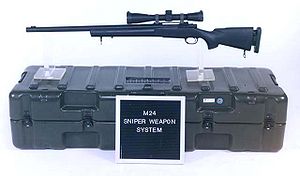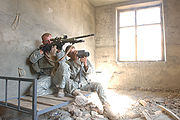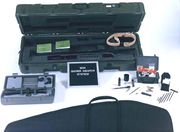M24 Sniper Weapon System
| Rifle, 7.62 mm, Sniper Weapon System, M24 | |
|---|---|
 The M24 rifle. |
|
| Type | Sniper rifle |
| Place of origin | |
| Service history | |
| In service | 1988–present |
| Used by | See Users |
| Wars | Operation Desert Storm Operation Iraqi Freedom Operation Enduring Freedom |
| Production history | |
| Designed | 1988 |
| Manufacturer | Remington Arms |
| Produced | 1988–c.2010 |
| Variants | M24A2, M24A3 |
| Specifications | |
| Weight | 5.4 kg (11.88 lbs) empty, w/. sling, without scope (M24) 7.3 kg (16 lbs) max weight with day optical sigh, sling swivels, carrying strap, fully loaded magazine[1] 5.6 kg (12.32 lbs) empty, w/. sling, without scope (M24A3). |
| Length | 1,092 mm (43 in) (M24A1, M24A2); (46.5 in) (M24A3) |
| Barrel length | 660.4 mm (24 in)(M24A1, M24A2); (29 in) (M24A3) |
|
|
|
| Cartridge | 7.62x51mm NATO (M24A2), .300 Winchester Magnum (M24A1), .338 Lapua Magnum (M24A3) |
| Action | Bolt-action |
| Rate of fire | @20 rpm |
| Muzzle velocity | 2,580 ft/s (790 m/s) w/M118LR Sniper load (175 gr.) |
| Effective range |
|
| Feed system | 5-round internal magazine (M24A1), 10-round detachable box magazine (M24A2), 5-round detachable box magazine (M24A3) |
| Sights | Telescopic; detachable backup iron sights |
The M24 Sniper Weapon System (SWS) is the military and police version of the Remington 700 rifle, M24 being the model name assigned by the United States Army after adoption as their standard sniper rifle in 1988. It is also used by the Israeli Defence Forces. The M24 is referred to as a "weapons system" because it consists of not only a rifle, but also a detachable telescopic sight and other accessories.
The M24 was designed to use the "long-action" version of the Remington M700 BDL. This was chosen because the Army wanted the ability to rebarrel the rifle from 7.62 NATO to the .300 Winchester Magnum cartridge if needed, which required a long action receiver.[2][3] Due to using a short action cartridge in a long action receiver and magazine box, rounds must be pushed to the rear of the magazine in order to ensure reliable feeding.
It originally came tapped for the Leupold Ultra M3 10x40mm fixed-power scope, which came with a circle-shaped etched-glass reticle. This was later replaced in 1998 by the cheaper Leupold Mk.4 LR/T M3 10x40mm first focal plane fixed-power scope with a mil-dot reticle.[4]
N.B.: The first number is the scope's magnification (10) and the second number in millimeters (40mm) is the diameter of the objective lens. A fixed power scope has only one magnification (e.g., 10x) and a variable power scope can be adjusted to focus between a range of magnifications (e.g., 3-9x is adjustable from a minimum power of 3x to a maximum power of 9x).
It comes with a detachable Harris 6-9" BRM-S swivel bipod unit.
The M24 SWS was to be replaced with the M110 Semi-Automatic Sniper System, a contract awarded to Knight's Armament Company. However, the Army still continued to acquire M24s from Remington until February 2010 and the M24 is being upgraded to the A2 standard in many cases, and continues to serve.[5]
Contents |
Specifications

Sights: Leupold Ultra M3 10 x 40mm fixed power, Leupold Ultra M3A 10 x 40mm fixed power, or Leupold Mk.4 LR/T M3 10 x 40mm fixed power scope. Detachable emergency Redfield-Palma International back-up iron sights, fitted with tabs that fit into slots machined into the front and back of the barrel.
Barrel: Made of 416R Stainless Steel. The bore twist is 1-turn-in-11.25 inches [1:285.75 mm] and the rifling is 5 radial lands and grooves (5-R) with a right-hand (RH) twist. Because of the odd number of lands, none of the lands are 180° apart, i.e. in direct opposition. This results in less bullet deformation, which (at least in theory) produces more consistent point of impact. In 5-R rifling, the "side" of the land is cut a a 65° angle, rather than 90° in conventional rifling. This results in less barrel fouling, and more consistent point of impact, compared to conventional rifling when relatively high numbers of rounds are fired between cleaning, as might be expected in military applications.
Stock: H-S Precision PST-11 stock. The stock secures the barrel via an aluminum bedding block to keep it rigid. A twin-strut extension that pulls out of the butt is adjustable for a 2-inch [50.8mm] length-of-pull. This is effected by a thick wheel on a central grooved pillar for adjusting the length and a thin locking ring behind it locks the thick wheel in place. The latter is notorious for failing, causing the extension to slide back and forth. Also a styrofoam core designed to reduce the stock's weight would absorb water if it was carried in the rain or soaked in a stream or river, making the weapon heavy and unbalanced.
Accuracy: According to MIL-R-71126(AR), the M24 shall achieve the accuracy results stated below when using M118 Special Ball and fired from a Government approved machine rest. The average mean radius shall be less than or equal to the following values:[1]
- 200 yards (182.9 m): 1.3 inches
- 200 metres (218.7 yd): 1.4 inches
- 300 yards (274.3 m): 1.9 inches
Maximum effective range is given as 875 yards (800 meters), but record shots have been made with the M24 at over 1,000 metres (1,094 yd). Meanwhile, the standard optical sight has a maximum elevation adjustment of 1,000 metres (1,094 yd).
Match-Grade Ammunition
- 7.62 x 51mm M118 Match Grade A 173-grain round.
- 7.62 x 51mm M118LR Long Range A 175-grain round using Sierra MatchKing Hollow Point Boat Tail projectiles.
- 7.62mm M118 Long Range Performance Data:
- Muzzle velocity (nominal): 2,580 f/s (786 m/s)
- Chamber pressure (typical): 52,000 psi (358.6 MPa)
- Action time (max): 4 ms
- Average horizontal spread at 1,000 meters: 10.3 in (0.984 MOA)
- Average vertical spread at 1,000 meters: 14 in (1.337 MOA)[6]
According to JBM Ballistics,[7] using the G7 ballistic coefficient provided by Bryan Litz, the 7.62mm M118 Long Range 7.62x51mm NATO cartridge, when fired at its nominal muzzle velocity of 786 m/s (2,580 ft/s), should have approximately 878 m (960 yd) supersonic range under International Standard Atmosphere conditions at sea level (air density ρ = 1.225 kg/m3).
- 7.62 x 51mm MK 316 MOD 0 Special Ball, Long Range A 175-grain round consisting of Sierra MatchKing Hollow Point Boat Tail projectiles, Federal Cartridge Company match cartridge cases and Gold Medal Match primers and an undisclosed modified extruded propellant. The 7.62 x 51mm MK 316 MOD 0 Special Ball, Long Range cartridges have an accuracy requirement based around 10-round shotgroups.
- The average extreme spread radius for 10-round shotgroups shall be less than or equal to the following values:
- 600 yd: 7.0 in (first Production Lot). This equates to a ≤ 1.1 MOA requirement at 548.6 m.
- 300 yd: 3.5 in (after first Production Lot). This equates to a ≤ 1.1 MOA requirement at 274.3 m.
The maximum muzzle velocity standard deviation is set at 15 ft/s (4.57 m/s). Information published on acceptance tests regarding five MK 316 MOD 0 cartridge production lots indicated a sub 2.4 in at 300 yd performance. This equates to a sub 0.8 MOA performance at 274.3 m for the listed ammunition lots.[8]

M24 Variants
XM24A1
An experimental variant re-chambered for the .300 Winchester Magnum (7.62×67mm) round. It was not adopted by the US Army due to concerns that operatives in the field would not be able to acquire the special ammo. Also, the available .300 Winchester Magnum ammo that was procured sometimes misfired due to incompletely-burned propellant in the longer cartridge.
M24A2
Remington has developed an improved version of the M24 rifle, known as the M24A2. The A2 model features a detachable 10-round magazine, top-mounted and adjustable side-mounted Picatinny rails (advertised by Remington as "MARS", or Modular Accessory Rail System), barrel modifications designed to accommodate a sound suppressor, and an improved H-S Precision PST-25 stock with adjustable cheek height and length of pull. Existing M24s can also be converted into M24A2s, which replaces the stock and adds the new detachable magazine feed. The conversion requires a rebarreling of the weapon so it could take the OPS silencer.
M24A3
Remington has also developed the M24A3 SWS, a variant of the M24 chambered for the .338 Lapua Magnum round (8.58x70mm) and feeding from a 5-round detachable box magazine.[9] It comes tapped for the Leupold Mk. 4 M1LR/T 8.5 - 25 x 50mm Variable Power day scope. It can also use detachable front and rear Back-Up Iron Sights in an emergency (BUIS units are standard accessories that can be fitted to the Picatinny Rail that runs on the top of the receiver and along the barrel).
U.S. Army 2009 solicitation for a M24 reconfiguration
The U.S. Army has put out a solicitation in May 2009 for reconfiguring M24 Sniper Weapon Systems currently available in Army inventory consisting of a:[10]
- Rebarreling/rechambering the SWS's barrel optimized to accommodate Mk 248 (DODIC A191) .300 Winchester Magnum ammunition.
- Replacement of existing weaver rails with a MIL-STD-1913 rail capable of accommodating both a day optic and in-line forward mounted, AN/PVS-26 (NSN 5855-01-538-8121) image intensified (I2) night vision device.
- Reconfiguring the stock with a stock that incorporates a detachable box magazine, adjustable comb and length of pull.
- Addition of a detachable sound suppressor as well as any necessary barrel modifications required for a sound suppressor interface.
- Replacement of the existing day optic sight (DOS) and rings with an Army specified variable power day optic and compatible rings.
The US government purchased MK 248 MOD 1 .300 Winchester Magnum match-grade ammunition in 2009 for use in .300 Winchester Magnum sniper rifles like the U.S. Navy Mk.13 SWS or reconfigured M24 SWS's. This ammunition was developed as a .300 Winchester Magnum Match Product Improvement (PIP) and uses the 14.26 g (220 gr) Sierra MatchKing Hollow Point Boat Tail (HPBT) very-low-drag bullet fired at a nominal muzzle velocity of 869 m/s (2,850 ft/s) ± 15.2 m/s (50 ft/s). According to the U.S. Navy this ammunition should increase the maximum effective range of .300 Winchester Magnum sniper rifle systems to 1,370 m (1,500 yd), decrease wind defection on bullets in flight and use a reduced muzzle flash propellant that remains temperature stable across an operational temperature range of -32 °C tot 74 °C (-25 °F to 165 °F).[11][12][13] According to JBM Ballistics,[7] using the G7 ballistic coefficient provided by Bryan Litz, the Mk 248 MOD 1 .300 Winchester Magnum cartridge, when fired at its nominal muzzle velocity of 869 m/s (2,850 ft/s), should have approximately 1,286 m (1,406 yd) supersonic range under International Standard Atmosphere conditions at sea level (air density ρ = 1.225 kg/m3).
Users

 Israel: Israel Defense Forces.[14]
Israel: Israel Defense Forces.[14] Japan[15]
Japan[15] Lebanon[16]
Lebanon[16] United States: Used by the US Army.[17] Also used by various police SWAT teams.[18]
United States: Used by the US Army.[17] Also used by various police SWAT teams.[18]
See also
- List of individual weapons of the U.S. Armed Forces
- List of crew-served weapons of the U.S. Armed Forces
References
- ↑ 1.0 1.1 MIL-R-71126(AR) at everyspec.com.
- ↑ "M24 Sniper Rifle". Military.com. http://tech.military.com/equipment/view/89050/m24-sniper-rifle.html. Retrieved 10 August 2010.
- ↑ "Remington M24 Sniper Weapon System". Remington Military Products Division web site. Remington. http://www.remingtonmilitary.com/m24sws.htm. Retrieved 10 August 2010.
- ↑ Leupold || Mark 4 10x40mm LR/T M3 Front Focal.
- ↑ DefenseLink: Contracts for Wednesday, July 16, 2008.
- ↑ ATK - 7.62mm M118 Long Range.
- ↑ 7.0 7.1 JBM Ballistics freeware online ballistic calculator.
- ↑ U.S. Navy Small Arms Ammunition Advancements - 7.62MM Special Ball, Long Range, NAVSEA Warfare Centers Crane.
- ↑ Remington M24A3 SWS.
- ↑ M24 Sniper Weapon System (SWS) Reconfiguration Solicitation Number: W15QKN-09-X-0413.
- ↑ DETAIL SPECIFICATION CARTRIDGE, .300 WINCHESTER MAGNUM MATCH, MK 248 MOD 1 DODIC AB43, NSN 1305-01-568-7504 Revision A 17 March 2009.
- ↑ U.S. Navy Small Arms Ammunition Advancements.
- ↑ $49.9M US Contract for 300 Winchester Magnum Ammo.
- ↑ http://www.isayeret.com/updates/pastphotos3.htm
- ↑ "対人狙撃銃" (in Japanese). http://rightwing.sakura.ne.jp/equipment/jgsdf/firearms/m24sws/m24sws.html. Retrieved 2009-11-04.
- ↑ Castelli, Christopher J. (September 2008). "Department of Defense to Equip Lebanon’s Special Forces with Small Arms, Vehicles". The DISAM Journal (Defense Institute of Security Assistance Management) 30 (3): 123. http://www.disam.dsca.mil/pubs/Vol%2030_3/Castelli.pdf. Retrieved January 18, 2009.
- ↑ http://world.guns.ru/sniper/sn11-e.htm
- ↑ McManners, Hugh (2003). Ultimate Special Forces. DK Publishing, Inc. ISBN 0-7894-9973-6.
External links
- Remington Military M24 SWS page
- Remington Law Enforcement M24 SWS page
- Operator's Manual
- FM 23-10 Sniper Training
- Mel's SniperCentral M24 SWS
- Modern Firearms
|
|||||||||||||||||||||||||||||||||||||||||||
|
|||||||||||||||||||||||||||||||||||||||||||||||||||||||||||||||
